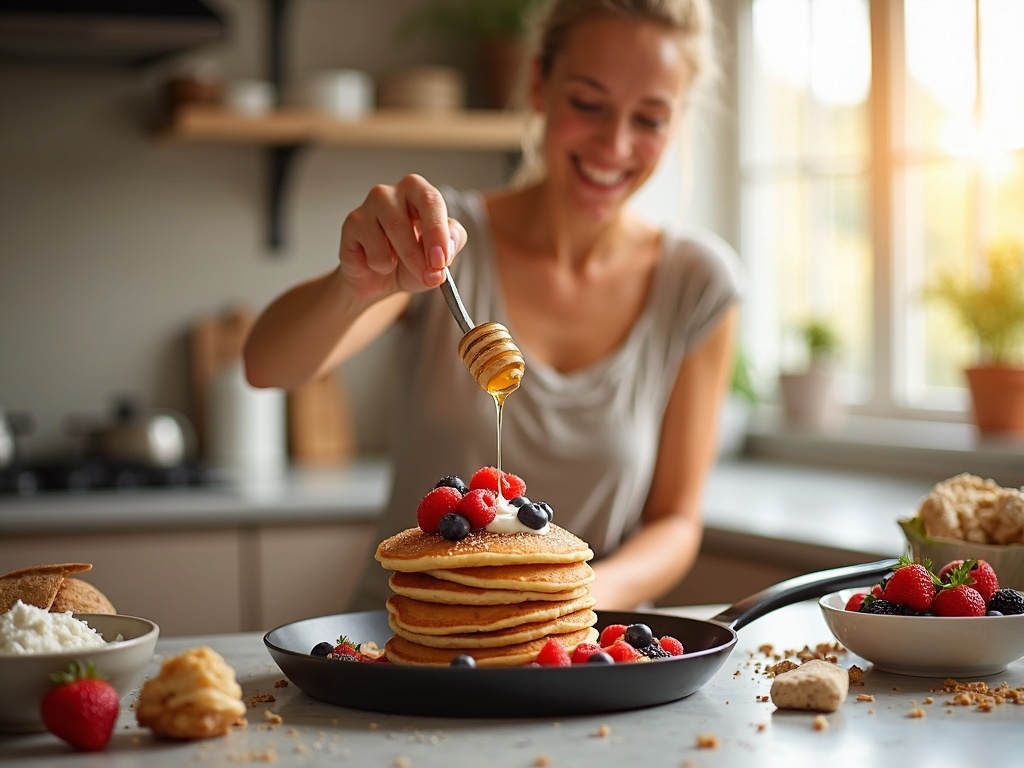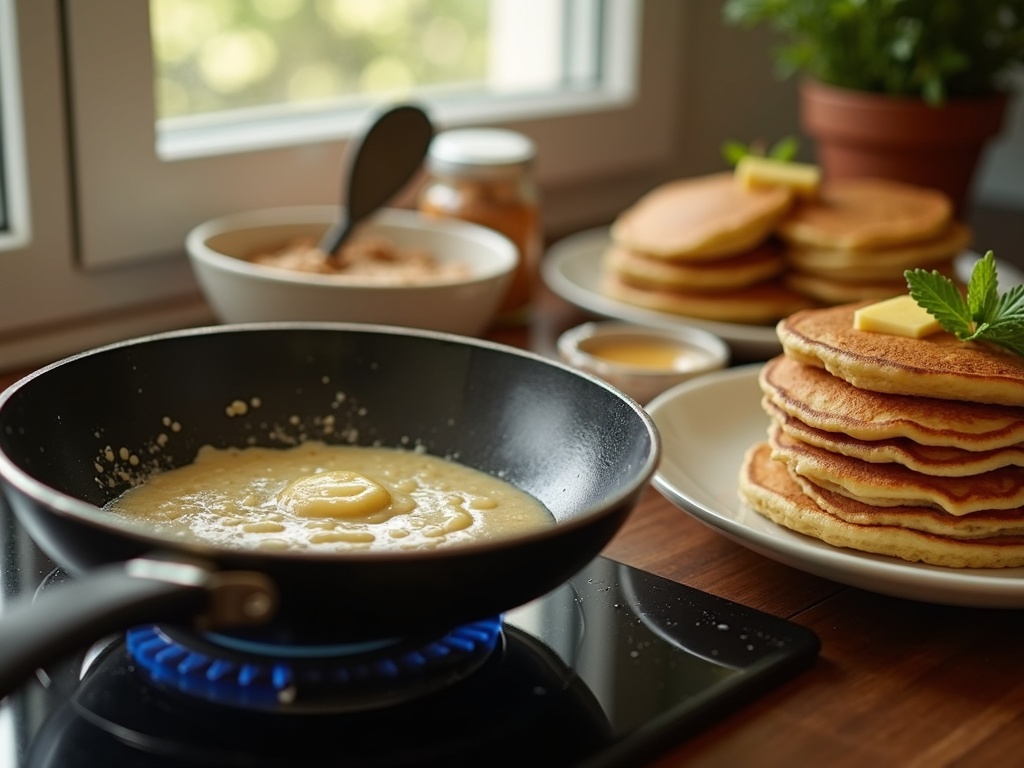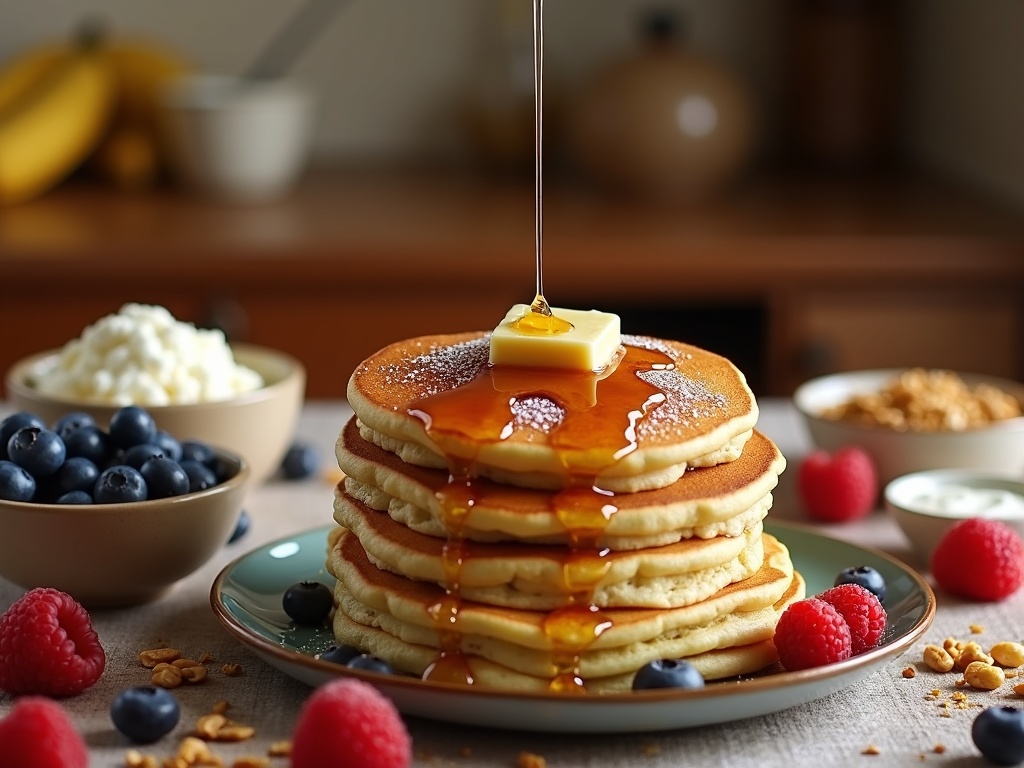Homemade pancakes transform from a simple breakfast into a culinary canvas when you master the perfect balance of ingredients and cooking techniques. The basic formula—flour, eggs, milk, and baking powder—creates the foundation for countless variations, from fruit-studded stacks to protein-packed health-conscious versions that can satisfy any breakfast craving.
Find In This Article
Key Takeaways
- The ideal pancake batter uses a 1:1:1 ratio (1 cup flour, 1 cup milk, 1 egg) with 2 teaspoons of baking powder, and benefits from a 10-15 minute rest before cooking.
- Cook pancakes at medium heat (around 375°F) and flip when bubbles form on top and edges look set—typically after 2-3 minutes.
- Whole wheat flour, plant-based milks, and protein-rich add-ins like Greek yogurt or seeds can transform pancakes into a more nutritious breakfast option.
- Fresh fruits, nuts, and spices make excellent mix-ins, while toppings like maple syrup, fruit compotes, and nut butters can be portioned thoughtfully for flavor without excess calories.
- Temperature control and minimal mixing (leaving small lumps in the batter) are professional techniques that result in perfectly golden, fluffy pancakes.
The Perfect Pancake Batter
Creating a delicious batch of fluffy homemade pancakes starts with mastering the basic batter. I’ve tested countless recipes and found that the perfect pancake relies on a simple ratio that balances ingredients for ideal texture and taste.
The Golden Ratio for Pancake Success
The foundation of great pancakes comes down to this essential formula: 1 cup all-purpose flour (120g), 1 large egg, 1 cup milk (240ml), and 2 teaspoons of baking powder. This ratio creates a batter that’s neither too thick nor too runny—just right for cooking up perfect pancakes every time.
Each ingredient plays a crucial role in your pancake’s structure and flavor:
- Eggs provide structure and richness, binding everything together
- Baking powder creates those tiny air bubbles that make pancakes fluffy
- Milk adds moisture and helps create a smooth, pourable consistency
- Flour forms the foundation, giving pancakes their substance
After mixing these ingredients until just combined (small lumps are actually good!), I let the batter rest for 10-15 minutes. This waiting period is often overlooked but makes a huge difference. The rest allows the gluten to relax and the baking powder to activate, resulting in pancakes that rise beautifully when they hit the pan.
Cooking Techniques for Perfect Results
The right cooking temperature is just as important as the batter itself. Medium heat (around 375°F/190°C) gives pancakes their signature golden-brown exterior while ensuring the inside cooks properly. Too hot, and they’ll burn before cooking through; too cool, and they’ll become dense and soggy.
I’ve found the bubble method to be foolproof when determining when to flip. Pour about ¼ cup of batter onto your preheated surface and wait until bubbles form on the top and the edges look set—typically 2-3 minutes. This visual cue tells you the bottom has browned perfectly and it’s time to flip.
After flipping, cook for another 1-2 minutes until the second side browns. Remember that the first pancake often turns out less than perfect as the pan reaches the ideal temperature—consider it your test run!
For added variety, I sometimes incorporate special ingredients like mashed bananas, blueberries, or chocolate chips. For something truly unique, try making ube mochi pancakes for a delightful purple twist on this classic dish.
The versatility of pancakes makes them perfect for any breakfast occasion—from quick weekday meals to leisurely weekend brunches. I like to serve mine with a pat of butter and pure maple syrup, but honey, fruit compote, or a dusting of powdered sugar work beautifully too.
With this basic ratio and technique mastered, you’ll have the confidence to experiment with flavors and styles, creating your own signature pancake recipe that family and friends will request time and again. The magic happens when you understand not just the ingredients but how they work together to create that perfect pancake texture—crisp at the edges, tender in the middle, and utterly satisfying with every bite.
Nutritional Benefits and Smart Swaps
I’ve discovered that understanding the nutritional content of homemade pancakes can help you make informed choices about this beloved breakfast item. A standard 4-inch pancake contains approximately 90-100 calories, making it easy to track your intake when enjoying this morning treat. Each pancake typically provides about 2g of protein, 15g of carbohydrates, and 4g of fat, offering a balanced macronutrient profile that can fit into various dietary patterns.
One of the simplest ways to boost the nutritional value of your homemade pancake recipe is by switching to whole wheat flour. This swap significantly increases the fiber content of your pancakes, which supports digestive health and helps you feel fuller longer. The added fiber also slows down the absorption of sugars, potentially preventing those mid-morning energy crashes that can happen after a carb-heavy breakfast.
Smart Ingredient Substitutions
The choice of milk in your pancake batter affects both texture and nutritional content. Here are some alternative milk options and their benefits:
- Almond milk: Creates lighter pancakes with fewer calories and adds a subtle nutty flavor
- Oat milk: Produces a slightly denser texture with added fiber and a natural sweetness
- Coconut milk: Delivers rich, fluffy pancakes with tropical notes (though higher in fat)
- Soy milk: Provides extra protein and creates a texture similar to dairy milk
When it comes to sweeteners, I’ve found that natural options can enhance both flavor and nutritional profile. Honey or pure maple syrup make excellent substitutes for refined sugar in your pancake batter. These natural sweeteners contain trace minerals and antioxidants that processed sugar lacks. Plus, their distinct flavors add character to your breakfast pancakes that plain sugar simply can’t match.
For a truly nutritious twist on traditional pancakes, try incorporating fruit directly into your batter. Mashed bananas, blueberries, or grated apples add natural sweetness, moisture, and valuable nutrients. This technique can help you reduce the amount of added sweetener needed while boosting vitamin content.
Protein enthusiasts can boost their pancakes by adding a scoop of protein powder or Greek yogurt to the batter. This modification increases the protein content significantly, turning a carb-heavy breakfast into a more balanced meal that keeps hunger at bay for hours.
For a fun cultural twist with added nutrition, ube mochi pancakes incorporate purple yam (ube) which contains vitamins, fiber, and antioxidants not found in standard pancake recipes.
Toppings represent another opportunity to enhance nutritional value. Fresh berries add antioxidants and vitamin C, while a dollop of Greek yogurt provides protein and probiotics. Nuts and seeds sprinkled on top contribute healthy fats, protein, and a satisfying crunch.
The cooking method matters too. Using a non-stick pan can reduce the need for excessive butter or oil. Alternatively, a light spray of olive oil provides heart-healthy fats compared to butter.
For those monitoring their blood sugar levels, adding cinnamon to pancake batter can help regulate glucose response. This warming spice not only enhances flavor but may also help moderate the impact of carbohydrates on blood sugar levels.
By making thoughtful ingredient choices, homemade pancakes can transform from a mere indulgence into a nutritious meal that fuels your day. The flexibility of pancake recipes means you can adjust them to suit nearly any dietary preference or nutritional goal while still enjoying this classic breakfast favorite.
Creative Mix-ins and Variations
Pancakes become an entirely different experience when you add delicious mix-ins and variations. I’ve experimented with countless combinations over the years and found that a few simple additions can transform your basic pancake recipe into something extraordinary.
Fruits and Sweet Add-ins
Blueberries remain the classic pancake mix-in for good reason. Adding 1/2 cup of fresh blueberries to your batter adds just 42 calories while packing your breakfast with powerful antioxidants. For the best distribution, I recommend sprinkling the berries directly onto each pancake after pouring the batter into the pan rather than mixing them into the entire batch.
Banana slices create naturally sweet pancakes and pair perfectly with a sprinkle of chocolate chips for an indulgent morning treat. The trick with bananas is to slice them thin and place them carefully on the cooking pancake so they caramelize beautifully.
For those looking for more texture, try these options:
- Chopped walnuts or pecans add protein and a satisfying crunch
- Dried cranberries or cherries provide chewy sweetness
- Shredded coconut creates tropical flavor notes
- Diced apples with cinnamon create a warm, comforting combination
Spices can completely transform your pancakes without adding calories. A teaspoon of cinnamon in the batter adds warmth and complexity, while cardamom, nutmeg, or pumpkin spice can create seasonal variations that will impress your family.
For dietary restrictions, I’ve found that plant-based pancakes can be just as delicious. Vegan versions using plant milk and flax eggs work beautifully with all these mix-ins. The ube mochi pancakes variation offers a unique purple color and chewy texture that’s become increasingly popular.
When adding fruits that release moisture like strawberries or peaches, I pat them dry first to prevent soggy pancakes. For chocolate chips, use mini ones for better distribution throughout each bite.
The key to successful mix-ins is moderation – about 1/2 cup total add-ins per batch of batter ensures you taste the pancake itself while enjoying the additional flavors. By keeping your additions balanced, you’ll create pancakes that are visually appealing, texturally interesting, and absolutely delicious every time.
Toppings That Transform
The perfect pancake is only half the story – what you put on top can elevate your breakfast from simple to spectacular. I’ve found that choosing the right toppings not only enhances flavor but can also add nutritional value to your morning meal. Let’s explore some options that’ll transform your homemade pancakes into a truly memorable dish.
Classic and Nutritious Options
Nothing beats the traditional combination of pancakes and maple syrup. This golden liquid adds a rich, caramel-like sweetness that complements the subtle flavor of pancakes perfectly. However, it’s good to know that just one tablespoon of maple syrup contains approximately 50 calories, so I recommend drizzling rather than drowning your stack for the best balance of flavor and nutrition.
Fresh fruits are my go-to topping when I want to add natural sweetness and nutritional value. Berries like strawberries, blueberries, and raspberries aren’t just colorful additions – they pack serious antioxidant power and vitamin C. Sliced bananas add potassium and natural sweetness, while diced apples with a sprinkle of cinnamon create a delicious fall-inspired topping.
For a protein boost that’ll keep you fuller longer, consider adding a dollop of Greek yogurt. This creamy addition provides protein and probiotics while balancing the sweetness of other toppings. Nut butters like almond or peanut butter melt beautifully on warm pancakes and add healthy fats and protein – just a tablespoon can transform your breakfast into a more substantial meal.
Creative and Healthier Alternatives
Homemade fruit compotes offer an excellent alternative to store-bought syrups, with far less sugar and more nutritional benefits. I love making simple berry compotes by simmering fresh or frozen berries with a touch of honey or maple syrup until they break down into a thick, jammy consistency. The result is a vibrant, fruity topping that’s packed with flavor and nutrients.
For something a bit different, try toasted nuts or seeds sprinkled over your pancakes. They add a satisfying crunch and heart-healthy fats. Toasted coconut flakes paired with a light drizzle of honey can transport your taste buds to tropical destinations, especially when served with ube mochi pancakes.
Portion control is key when it comes to toppings, particularly the sweeter varieties. Here are some guidelines I follow:
- Limit maple syrup to 1-2 tablespoons per serving
- Aim for ½ cup of fresh fruit toppings
- Keep nut butters to 1-2 tablespoons
- For yogurt, a ¼ cup serving is usually sufficient
- Limit chocolate chips or cocoa nibs to 1 tablespoon as an occasional treat
The beauty of pancake toppings is their versatility. I like to set up a topping bar when serving pancakes to guests, allowing everyone to customize their own stack. This not only makes for an interactive breakfast experience but ensures everyone gets exactly what they love.
Don’t be afraid to mix and match toppings for unique flavor combinations. A dollop of Greek yogurt with a sprinkle of granola and fresh berries creates a parfait-inspired topping that’s both satisfying and nutritious. Or try a spread of almond butter topped with thinly sliced apples and a light dusting of cinnamon for a protein-packed option.
Remember that the best toppings complement rather than overwhelm your pancakes. The goal is to enhance the flavor of your homemade creation while adding nutritional benefits that’ll start your day on the right note.
Health-Conscious Choices
Making pancakes at home gives me complete control over what goes into my breakfast. This flexibility lets me adjust recipes to match dietary needs without sacrificing flavor. A typical three-pancake stack contains about 270-300 calories before adding any toppings, making it a reasonable breakfast option when prepared thoughtfully.
Smarter Ingredient Swaps
I’ve found several simple substitutions that can transform traditional pancakes into healthier versions:
- Milk alternatives significantly impact the nutritional profile of pancakes. Almond milk creates a lighter pancake with fewer calories and less fat than whole milk. One cup of almond milk typically contains just 30-40 calories compared to 150 calories in whole milk.
- Coconut oil instead of butter adds beneficial medium-chain triglycerides but doesn’t reduce the fat content – it simply changes the type of fat.
- Flour choices make a substantial difference too. Using whole grain flour instead of all-purpose flour increases the fiber content dramatically – from about 1 gram to 4 grams per serving. This keeps me fuller longer and supports better digestion. For quick pancake recipes that still maintain nutritional value, I often use a 50/50 blend of whole wheat and all-purpose flour.
- The biggest calorie difference often comes from toppings. Traditional maple syrup adds about 200 calories per quarter cup, while fresh berries add only 25-30 calories for the same volume. When making breakfast healthier, I’ve switched to Greek yogurt with a touch of honey instead of whipped cream, saving roughly 100 calories per serving.
- For those looking for unique healthy options, ube mochi pancakes incorporate purple yam, which adds antioxidants and a naturally sweet flavor without excessive sugar.
- I’ve discovered that protein-rich additions like hemp seeds, chia seeds, or a scoop of protein powder can transform pancakes from a carb-heavy meal into a more balanced breakfast. Adding just one tablespoon of chia seeds introduces 2 grams of protein and 4 grams of fiber with minimal impact on flavor.
By being intentional with ingredients and toppings, I’ve turned an occasional weekend treat into a regular breakfast option that supports my health goals while still delivering the comfort and satisfaction that makes pancakes so beloved.

Make Them Like a Pro
Learning to create perfect pancakes takes practice, but with a few key techniques, you’ll be flipping golden discs like a seasoned chef in no time. I’ve collected some professional tips that will transform your weekend breakfast routine.
Mastering the Fundamentals
Temperature control is crucial for evenly cooked pancakes. I start with a medium-low heat setting on my stove, which prevents burning while allowing the pancake to cook through. Before pouring batter, I test the pan by flicking a few drops of water on the surface—if they sizzle and dance, the temperature is just right. Too hot, and your pancakes will have burnt exteriors with raw centers; too cool, and they’ll become dense and pale.
For perfect timing, I watch for specific visual cues. The first signal comes when tiny bubbles form across the surface of the batter. When these bubbles begin to pop and leave small holes that don’t fill back in, it’s time to flip. This usually takes about 2-3 minutes on the first side, and just 1-2 minutes on the second side.
Proper mixing makes a significant difference in texture. I combine wet and dry ingredients separately, then gently fold them together until just barely combined. Those small lumps you see? They’re actually good! Overmixing activates the gluten in flour, resulting in tough, chewy pancakes instead of light, fluffy ones.
The right equipment elevates your quick pancake recipe to restaurant quality. I recommend:
- A heavy-bottomed non-stick skillet or well-seasoned cast iron pan for even heat distribution
- A flexible silicone spatula for perfect flips without tearing
- A ladle or 1/4-cup measuring cup for consistent portion sizes
- An instant-read thermometer if you’re just starting out (325-350°F is ideal)
Achieving that signature golden-brown color comes down to a few secret tricks. I add a tablespoon of sugar to my batter, which helps with caramelization. A touch of melted butter in the batter adds flavor and helps with browning. For special occasions, try making ube mochi pancakes for a vibrant purple twist on this classic.
Remember to wipe your pan clean between batches if using butter or oil, as leftover residue can burn and affect the color of subsequent pancakes. With these techniques in your cooking arsenal, you’ll consistently produce perfect pancakes that would make any breakfast chef proud.

Sources:
Healthline, Homemade Pancakes: Ingredients and Nutrition
Serious Eats, How to Make Perfect Pancakes
United States Department of Agriculture, FoodData Central

